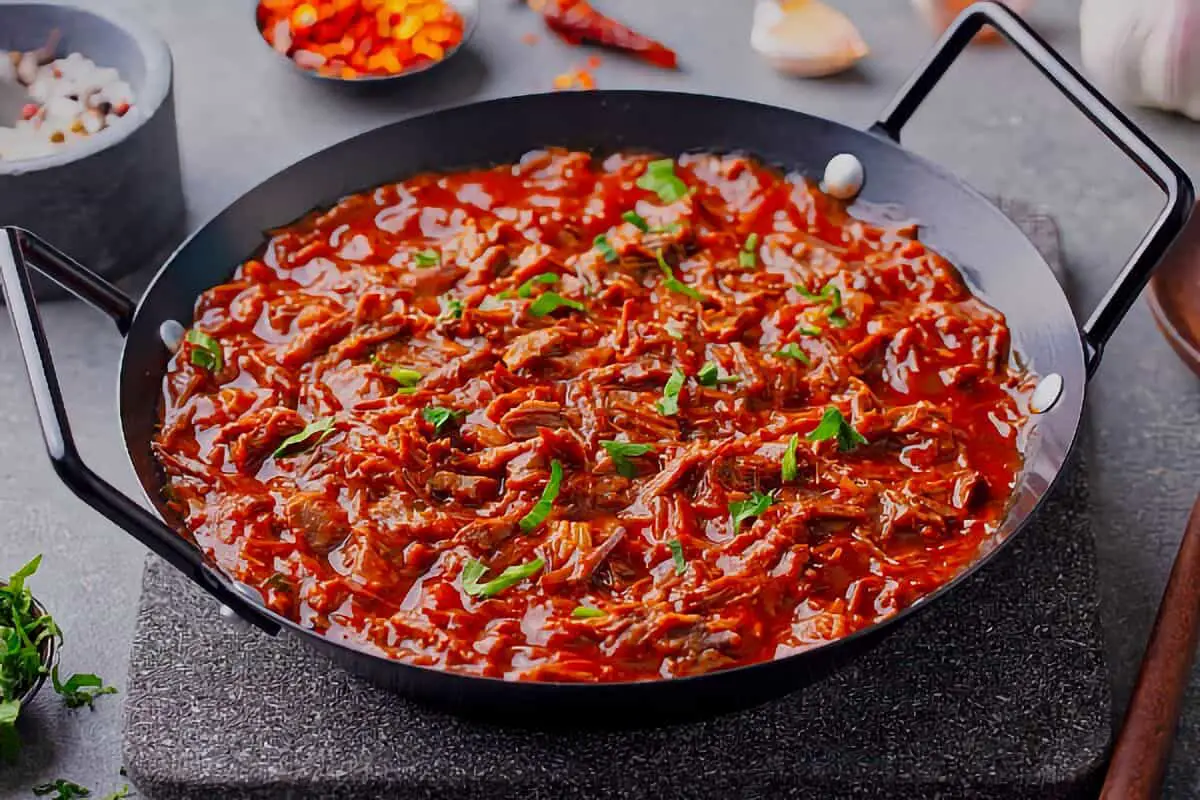I learned about the Guatemalan Hilachas recipe in my recent cooking class in Petapa, a fun town just outside Guatemala City. Petapa is a fun place that connects both city and countryside easily. The town has cool places like local markets and parks where you can see what people do every day. This place was perfect for discovering traditional Guatemalan food.
In cooking class, I found out about Hilachas, which is basically shredded beef in a yummy tomato sauce! It has beef, potatoes, and a bunch of different spices in it. The teacher taught us how to get the ingredients ready and cook them slowly until they had the right texture we were looking for.
The Guatemalan Hilachas recipe looked really good at first, which made a great impression! The bright red color and pieces of potato and soft meat made the dish look super yummy! The yummy smell of the sauce cooking filled the kitchen as we began making it.
When it was time to try the dish, I thought the flavors were really well balanced! The beef was super soft because of the sauce, and the potatoes made the meal feel really filling. The sauce had a nice zing from the tomatoes and spices that made it really interesting without being too much. The texture was really nice, and the shredded beef was super tender, almost melting in your mouth.
People in Petapa really like the Guatemalan Hilachas recipe. It’s something you have at family get-togethers and on special days. While I was figuring out how to make it, I saw that different families might have their own special ways of doing things that show what they like. This flexibility is what makes the dish super popular in Guatemalan cuisine!
After the cooking class, I went to the local markets in Petapa and got some fruits, meats, and spices for the Guatemalan Hilachas recipe. Talking to the vendors helped me learn about the local food culture. I found out how super important fresh ingredients are for making traditional meals!
My cooking class in Petapa was super cool! I got to learn about a traditional dish and discover all about the local food culture. It was really fun and interesting! Many locals really like the Guatemalan Hilachas recipe. Whether you enjoy it at home or at a local restaurant, this dish is a tasty example of Guatemalan comfort food and is definitely something to try if you want to experience the country’s flavors.
Ingredients For thGuatemalan Hilachas Recipe
Beef Shredded
Vegetable Oil
Finely Chopped Onion
Minced Cloves of Garlic
Diced Tomatoes
Diced Green Bell Pepper
Diced Red Bell Pepper
Tomato Paste
Ground Cumin
Dried Oregano
Paprika
Chili Powder
Beef Broth
White Vinegar
Salt
Black Pepper
Chopped Cilantro
Sliced Radishes
Lime Wedges
Cooked Rice or Warm Tortillas
Cooking Instructions For the Guatemalan Hilachas Recipe
Heat the vegetable oil in large pot or Dutch oven over medium heat. – Heat the oil to the right temperature for cooking. Ensure the pot is large enough to accommodate all the ingrdients. Use sturdy pot or Dutch oven for even heat distribution. Warm the oil gradually to prevent splattering. Keep an eye on the oil to prevent burning. Use wooden spoon to stir the oil for even heating. Test the oil’s temperature with small piece of onion.
Add the finely choppeed onion to the pot and sauté until translucent. – Finely chop thdonion to ensurd even cooking. Stir the onion occasionally to prevent burning. Sauté the onion until it becomes soft and fragrant. Adjust the heat as needed to avoid browning the onion. Use spatula to evenly distribute the onion in the pot. Spread the onion evenly across the bottom of the pot. Keep stirring until theonion turns translucent.
Add minced garlic and dice tomatoes to the pot. Cook until tomatoes soften. – Mince the garlic finely for better flavor distribution. Stir the garlic and tomatoes together to combine flavors. Cook until the garlicbecomes aromatic. Allow the tomatoes to release their juices for rich sauce. Keep the heat at medium level to avoid burning the garlic. Ensure the tomatoes are diced uniformly for even cooking. Stir gently to prevent the tomatoes from breaking apart.
Incorporate diced green and red bell peppers into the pot. Sauté until slightly tender. – Cut the bell peppers into evenly size dice for consistent cooking. Sauté the bell peppers until they start to soften. Stir occasionally to prevent the peppers from sticking to the pot.Maintain medium heat to cook the peppers evenly.Ensure the pot is not overcrowded with the bell peppers.Use wooden spatula to gently toss the peppers in the pot.Cook until the peppers become vibrant and slightly tender.
Stir in shredded beef, tomato paste, ground cumin, dried oregano, paprika, and chili powder (optional). – Shred the beef into thin, uniform pieces for even cooking. Incorporate the tomato paste to add depth to the sauce. Measure the spices accurately to balance the flavors. Sprinkle the ground cumin evenly over the ingredients. Add dried oregano to enhance the aromatic profile. Mix the spices well to evenly distribute their flavors. Adjust thchili powder amount accordinto desirespiciness.
Pour in beef broth and white vinegar. Season with salt and black pepper to taste. – Use beef broth for added richness and depth. Add white vinegar to balance the flavors and acidity. Gradually pour in the broth to prevent splashing.Season the dish with salt to enhance the flavors. Grind black pepper over the mixture for subtle kick.Taste and adjust the seasoning as needed. Stir gently to ensure even distribution of the liquid.
Reduce heat to low, cover the pot, and simmer for at least 1 hour, stirring occasionally. – Adjust the heat to low settingfor slow simmering. Cover the pot to trap heat and retain moisture.
Simmering for an extended period enhances the flavors. Stir occasionally to prevent the mixture from sticking. Ensure the sauce is simmering gently, not boiling rapidly. Keep the lid slightly ajar to allow steam to escape. Taste and adjust the seasoning during the simmering process.
5 Essiential Ingredients for Guatemalan Food
Guatemalan cuisine is deeply influenced by Mayan traditions, Spanish heritage, and locally sourced ingredients, resulting in a unique flavor profile that combines earthy, tangy, and spicy notes. Among the essential ingredients, corn stands out as a foundational staple. Known as maíz in Spanish, corn is the backbone of many dishes and a cultural symbol in Guatemala. It is used in various forms, from tortillas that accompany nearly every meal to tamales, which are made with a dough of masa and wrapped in banana leaves. Corn also features in drinks like atol de elote, a warm, sweet corn beverage. This ingredient’s versatility and accessibility make it a crucial part of Guatemalan meals, representing sustenance and tradition.
Chilies are another key ingredient that adds both flavor and heat to Guatemalan food. Though the cuisine is not as intensely spicy as other Central American foods, it often incorporates varieties like the guajillo, cobán, and *pasa* peppers, which add depth without overpowering the dish. These chilies are used in salsas, stews, and sauces, such as the rich sauce in pepian, a traditional meat stew. The use of mild to medium spiciness gives Guatemalan dishes their distinctive warmth and aroma, allowing the natural flavors of other ingredients to shine through.
Tomatoes are essential for the base of many Guatemalan recipes, providing acidity, richness, and natural sweetness. Often roasted to deepen their flavor, tomatoes are combined with chilies, onions, and spices to create rich sauces that are integral to dishes like hilachas (shredded beef stew) and jocon (a green chicken stew). The incorporation of tomatoes reflects Spanish influences while highlighting the country’s abundance of fresh produce.
Another indispensable ingredient is pepitoria, or pumpkin seeds. Ground pumpkin seeds are used to thicken sauces, add texture, and enhance flavors, particularly in stews and traditional dishes. In pepian, for instance, pepitoria gives the sauce a nutty undertone that balances the spices and brings a subtle richness. This ingredient not only adds depth but also reflects Guatemala’s pre-Columbian culinary heritage, as pumpkin seeds have been used in the region for centuries.
Finally, achiote (annatto) brings vibrant color and a mild, peppery flavor to Guatemalan food. The seeds are often ground into a paste or oil and used as a seasoning or natural colorant, giving dishes an appealing reddish hue. Achiote’s subtle flavor enhances recipes like recado rojo, a red sauce for meats and poultry. Together, these five ingredients — corn, chilies, tomatoes, pepitoria, and achiote — embody the flavors, history, and culinary creativity of Guatemalan cuisine, forming the foundation of its most cherished dishes.
10 Reasons I Love Guatemalan Food
1. Rich Cultural Influence – Guatemalan food is a tapestry of indigenous Mayan traditions and Spanish influences, creating a unique blend of flavors and techniques. This cultural richness is evident in every dish, from hearty stews to tamales, which are made with ancient methods and local ingredients that reflect the country’s history.
2. Fresh, Local Ingredients – The use of fresh, locally-sourced ingredients is a hallmark of Guatemalan cuisine. Vegetables, fruits, meats, and herbs are commonly grown or sourced nearby, adding to the freshness and authenticity of the dishes. From ripe tomatoes and vibrant chilies to fresh corn and herbs, Guatemalan food celebrates nature’s bounty.
3. Variety of Flavors – Guatemalan food offers a dynamic mix of flavors, from the mild and savory to the slightly spicy. Each dish is thoughtfully balanced, often combining elements like sweet, tangy, and spicy in a single recipe. For instance, the classic dish pepian has a blend of roasted vegetables, spices, and chili peppers, creating a depth of flavor that’s hearty and aromatic.
4. Traditional Cooking Techniques – Many Guatemalan recipes use traditional cooking techniques passed down through generations. Slow roasting, open-fire cooking, and clay pot preparation bring out authentic flavors and add a unique taste to dishes. These methods honor the roots of Guatemalan food, connecting each dish to a rich culinary past.
5. Diversity of Regional Dishes – Guatemala’s varied geography — from coastal regions to mountainous highlands — contributes to the diversity of regional foods. Each region has specialties that showcase the local environment and resources. The highlands, for instance, are known for hearty stews like kak’ik, a turkey soup with a blend of spices, while coastal areas feature more seafood-based dishes.
6. Colorful and Appealing Presentation – Guatemalan food is as visually appealing as it is delicious. Dishes are often vibrant, with colors from ingredients like tomatoes, chilies, and achiote, which adds a rich red hue. This lively presentation makes Guatemalan food inviting and showcases the beauty of local produce and spices.
7. Nutritious and Balanced Meals – Guatemalan dishes often incorporate a balanced mix of protein, vegetables, and grains. Corn, beans, and rice are staples, providing energy, while proteins like chicken, pork, and fish are commonly paired with nutrient-dense vegetables. This balance makes Guatemalan meals both satisfying and nutritious.
8. The Role of Maize (Corn) – Corn, or maíz, is central to Guatemalan cuisine and cultural identity. Used to make tortillas, tamales, and drinks like atol de elote, corn is a versatile ingredient that’s celebrated in countless ways. It represents the indigenous heritage and plays an essential role in nearly every meal, highlighting Guatemala’s deep connection to this staple crop.
9. Soulful Soups and Stews – Guatemalan cuisine is known for its rich soups and stews that bring comfort and warmth, like hilachas (shredded beef stew) and jocon (green chicken stew). These dishes are not only filling but deeply flavorful, often made with a blend of local spices, vegetables, and herbs that make each spoonful satisfying and complex.
10. Emphasis on Family and Community – Food in Guatemala is often a communal experience, with dishes designed to be shared. Meals like fiambre, a traditional salad served during Día de los Santos, bring families together in celebration. This sense of community and the tradition of sharing food adds another layer to the enjoyment of Guatemalan cuisine, making it not just about the food itself but about the connections it fosters.
These ten reasons capture what makes Guatemalan food unique, from its deep roots in tradition and family to its fresh ingredients and flavorful dishes. Each meal tells a story of the country’s history, geography, and cultural pride, making Guatemalan cuisine a truly special experience.
Most Popular Spices Used by Guatemalan Locals
Guatemalan cuisine is known for its balanced and flavorful use of spices, combining native ingredients with those introduced by Spanish settlers to create a rich tapestry of taste. One of the most prominent spices in Guatemalan cooking is Qchiote (annatto), which adds a mild peppery flavor and vibrant red hue to various dishes. Often ground into a paste, achiote is used in stews, tamales, and rice, infusing the food with an earthy flavor that complements other ingredients. Its coloring properties also enhance the visual appeal of traditional recipes, making it a versatile favorite among locals.
Another essential spice is Pepitoria, or ground pumpkin seeds. Unique to Guatemalan and neighboring Central American cuisines, pepitoria is often used to thicken sauces and add depth to stews, especially in dishes like pepian, where it contributes a subtle nutty flavor. Combined with roasted tomatoes, chilies, and other spices, pepitoria adds a distinctive richness that embodies the essence of Guatemalan cooking. This practice of using seeds as a seasoning reflects ancient Mayan cooking traditions, which continue to influence modern Guatemalan flavors.
Cinnamon is also widely used, particularly in sweet and savory dishes that highlight Guatemalan cuisine’s Spanish influence. Known locally as canela, cinnamon is a common ingredient in mole sauces, as well as in desserts and beverages like atol de elote (a corn-based drink). Its warm, aromatic flavor adds complexity to various recipes, bridging the flavors of local ingredients with a Spanish touch. Often paired with other spices, cinnamon is essential in creating the nuanced flavors found in Guatemalan comfort foods.
Allspice is another popular spice in Guatemala, bringing a warm, slightly peppery note to savory dishes and marinades. This spice, derived from the dried berries of the pimento tree, is known as *pimienta gorda* in Guatemala and is commonly used in soups, stews, and meats. Its subtle complexity enhances dishes without overpowering them, offering a rounded flavor profile that highlights the country’s love for balanced seasoning.
Chili Peppers such as cobán and guajillo varieties are staples for adding heat and depth. Though Guatemalan cuisine is not typically very spicy, the addition of these chilies gives dishes a gentle warmth and smokiness. Ground or used whole, these chilies appear in everything from salsas to stews, like the renowned kak’ik, a spicy turkey soup from the highlands. Together, these spices — achiote, pepitoria, cinnamon, allspice, and chili peppers — define the flavors of Guatemalan food, infusing it with tradition and the unique balance of local and global influences.
FAQ For the Guatemalan Hilachas Recipe
Q: What are the main components of the Guatemalan Hilachas recipe?
A: The Guatemalan Hilachas recipe primarily features shredded beef as the central ingredient, which is cooked until tender and flavorful. The dish is often prepared with a rich tomato and chili sauce that includes ingredients like garlic, onion, and bell peppers, which contribute depth and complexity to the overall flavor profile. Served over rice or with warm tortillas, the combination of the tender beef and savory sauce makes Guatemalan Hilachas a hearty and satisfying meal that is popular in traditional Guatemalan cuisine.
Q: How do you prepare the beef for the Guatemalan Hilachas recipe?
A: To prepare the beef for the Guatemalan Hilachas recipe, start by selecting a cut that is suitable for slow cooking, such as chuck roast or brisket. The beef should be seasoned and simmered in a pot of water until it is fork-tender, which may take several hours. Once cooked, the beef is then shredded into bite-sized pieces and mixed with the flavorful sauce, allowing the meat to absorb the rich flavors while maintaining its tender texture. This method ensures that the beef remains juicy and is perfectly seasoned for the dish.
Q: Can the Guatemalan Hilachas recipe be made ahead of time?
A: Yes, the Guatemalan Hilachas recipe can be made ahead of time, making it a great option for meal prep or gatherings. You can prepare the shredded beef and sauce in advance and store them separately in the refrigerator. When you’re ready to serve, simply reheat the components together until warmed through. This not only saves time but also allows the flavors to meld, making the dish even more delicious when enjoyed later.
Q: What sides are typically served with the Guatemalan Hilachas recipe?
A: The Guatemalan Hilachas recipe is typically served with sides that complement its rich flavors and hearty texture. A popular choice is white rice, which absorbs the savory sauce and balances the dish. Additionally, warm corn tortillas are often served alongside, perfect for scooping up the hilachas or wrapping around the meat. For a refreshing contrast, a simple side salad or some pickled vegetables can also enhance the meal, adding a crunchy and tangy element to the plate.
Q: Is it possible to create a vegetarian version of the Guatemalan Hilachas recipe?
A: While the traditional Guatemalan Hilachas recipe relies on shredded beef, a vegetarian version can be crafted using plant-based alternatives. One option is to use jackfruit or mushrooms, both of which can mimic the texture of shredded meat when cooked properly. By combining these substitutes with the same flavorful tomato and chili sauce, you can create a delicious and satisfying vegetarian interpretation of Guatemalan Hilachas that captures the essence of the original dish while catering to different dietary preferences.

Guatemalan Hilachas Recipe
Equipment
- Large pot or Dutch oven: Used for sautéing and simmering the Hilachas.
- Wooden spoon: Used for stirring and mixing ingredients.
- Spatula: Used for flipping and tossing ingredients.
- Cutting board: Used for chopping and dicing vegetables.
- Chef's knife: Used for cutting and preparing ingredients.
- Measuring cups and spoons: Used for precise ingredient measurements.
- Serving dishes and utensils: Used for serving the finished Hilachas.
Ingredients
- 2 pounds beef shredded (such as chuck roast}
- 2 tablespoons oil vegetable
- 1 onion finely chopped
- 2 tomatoes diced
- 1 bell pepper green diced
- 1 bell pepper red diced
- 2 tablespoons tomato paste
- 2 teaspoons cumin ground
- 1 teaspoon oregano dried
- 1/2 teaspoon paprika
- 1/2 teaspoon chili powde for added heat (optional)
- 1 cup beef broth
- 1/4 cup white vinegar
- Salt and black pepper to taste
- cilantro for garnish (optional)
- Sliced radishes Sliced for garnish (optional)
- Lime wedges for serving (optional
- Cooked rice or warm tortillas for serving
Instructions
Heat the vegetable oil in a large pot or Dutch oven over medium heat.
- a Heat the oil to the right temperature for cooking.
- b Ensure the pot is large enough to accommodate all the ingredients.
- c Use a sturdy pot or Dutch oven for even heat distribution.
- d Warm the oil gradually to prevent splattering.
- e Keep an eye on the oil to prevent burning.
- f Use a wooden spoon to stir the oil for even heating.
- g Test the oil's temperature with a small piece of onion.
Add the finely chopped onion to the pot and sauté until translucent.
- a Finely chop the onion to ensure even cooking.
- b Stir the onion occasionally to prevent burning.
- c Sauté the onion until it becomes soft and fragrant.
- d Adjust the heat as needed to avoid browning the onion.
- e Use a spatula to evenly distribute the onion in the pot.
- f Spread the onion evenly across the bottom of the pot.
- g Keep stirring until the onion turns translucent.
Add minced garlic and diced tomatoes to the pot. Cook until tomatoes soften.
- a Mince the garlic finely for better flavor distribution.
- b Stir the garlic and tomatoes together to combine flavors.
- c Cook until the garlic becomes aromatic.
- d Allow the tomatoes to release their juices for a rich sauce.
- e Keep the heat at a medium level to avoid burning the garlic.
- f Ensure the tomatoes are diced uniformly for even cooking.
- g Stir gently to prevent the tomatoes from breaking apart.
- Incorporate diced green and red bell peppers into the pot. Sauté until slightly tender.
- a Cut the bell peppers into evenly sized dice for consistent cooking.
- b Sauté the bell peppers until they start to soften.
- c Stir occasionally to prevent the peppers from sticking to the pot.
- d Maintain medium heat to cook the peppers evenly.
- e Ensure the pot is not overcrowded with the bell peppers.
- f Use a wooden spatula to gently toss the peppers in the pot.
- g Cook until the peppers become vibrant and slightly tender.
Stir in shredded beef, tomato paste, ground cumin, dried oregano, paprika, and chili powder (optional).
- a Shred the beef into thin, uniform pieces for even cooking.
- b Incorporate the tomato paste to add depth to the sauce.
- c Measure the spices accurately to balance the flavors.
- d Sprinkle the ground cumin evenly over the ingredients.
- e Add dried oregano to enhance the aromatic profile.
- f Mix the spices well to evenly distribute their flavors.
- g Adjust the chili powder amount according to desired spiciness.
Pour in beef broth and white vinegar. Season with salt and black pepper to taste.
- a Use beef broth for added richness and depth.
- b Add white vinegar to balance the flavors and acidity.
- c Gradually pour in the broth to prevent splashing.
- d Season the dish with salt to enhance the flavors.
- e Grind black pepper over the mixture for a subtle kick.
- f Taste and adjust the seasoning as needed.
- g Stir gently to ensure even distribution of the liquid.
Reduce heat to low, cover the pot, and simmer for at least 1 hour, stirring occasionally.
- a Adjust the heat to a low setting for slow simmering.
- b Cover the pot to trap heat and retain moisture.
- c Simmering for an extended period enhances the flavors.
- d Stir occasionally to prevent the mixture from sticking.
- e Ensure the sauce is simmering gently, not boiling rapidly.
- f Keep the lid slightly ajar to allow steam to escape.
- g Taste and adjust the seasoning during the simmering process.





4 comments
The shredded beef in this dish was tender, and the tomato sauce added a great touch.
I cant believe they left out the secret ingredient for Guatemalan Hilachas! Its all about that special touch that makes it authentic. Next time, spill the beans (or should I say beef?)!
I couldnt believe they left out the secret ingredient for Guatemalan Hilachas! Everyone knows that a pinch of cinnamon makes all the difference. Whos with me on this culinary conspiracy theory?
I cant believe they didnt mention the importance of using fresh cilantro in the Guatemalan Hilachas recipe! Its a game-changer, adds so much flavor. Cant imagine making it without it.